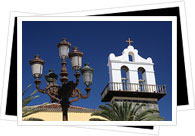Churches in Tenerife, Spain: Architectural Styles
 Due to the expanse of ocean separating the Canary Islands from mainland Spain as well as communication and travel limitations, the major architectural trends - Gothic, Renaissance, Baroque, etc. - that quickly spread throughout Europe made their way to Tenerife with a both a chronological and conceptual gap. For this reason, it's often difficult to assign a specific architectural style to Tenerife's many churches and cathedrals that, instead, boast rather eclectic appearances.
Due to the expanse of ocean separating the Canary Islands from mainland Spain as well as communication and travel limitations, the major architectural trends - Gothic, Renaissance, Baroque, etc. - that quickly spread throughout Europe made their way to Tenerife with a both a chronological and conceptual gap. For this reason, it's often difficult to assign a specific architectural style to Tenerife's many churches and cathedrals that, instead, boast rather eclectic appearances.
The churches' foundations are generally Gothic, as the Spanish conquest of Tenerife took place during the 15th century Gothic period. However, the churches then go on to include Renaissance arches and cloisters and then throw in Baroque entrances and façades. In the 18th century, churches began to adopt newer architectural styles and tendencies, such as the incorporation of a cupola above the cross and the eventual turn towards the newly-arrived and more sober Neoclassical style.
Churches in Tenerife, Spain: Common Characteristics
Despite the hodgepodge of architectural styles found in Tenerife's churches, there are several common characteristics which give the island's religious architecture some coherence. Externally, the churches in Tenerife often blend in well with the local architecture. While churches and cathedrals on mainland Spain are often constructed of stone, Tenerife's simple, white-washed exteriors - often with just a discreet side entrance - have an unmistakable island touch.
As for the interior floor plan of a typical Tenerife church, the bulk come in the shape of a western cross and contain three naves. Each nave is generally separated by Tuscan columns which are then employed to support perfectly semicircular arches. Much of the interior trim as well as the ceilings often showcase Mudéjar - elements of Christian art mixed with Arabic adornation - characteristics, such as repeated elaborate designs.